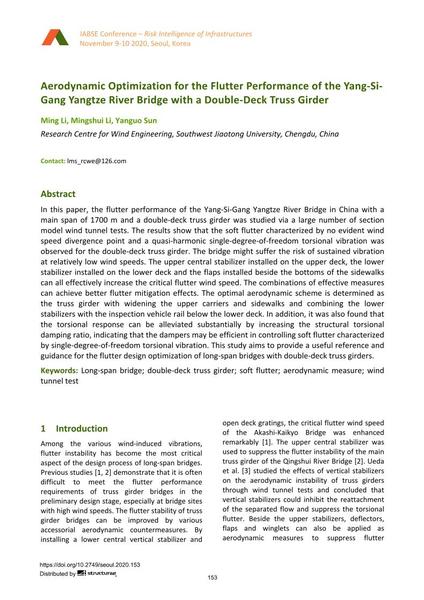Aerodynamic Optimization for the Flutter Performance of the Yang-Si- Gang Yangtze River Bridge with a Double-Deck Truss Girder

|
|
|||||||||||
Bibliografische Angaben
| Autor(en): |
Ming Li
(Research Centre for Wind Engineering, Southwest Jiaotong University, Chengdu, China)
Mingshui Li (Research Centre for Wind Engineering, Southwest Jiaotong University, Chengdu, China) Yanguo Sun (Research Centre for Wind Engineering, Southwest Jiaotong University, Chengdu, China) |
||||
|---|---|---|---|---|---|
| Medium: | Tagungsbeitrag | ||||
| Sprache(n): | Englisch | ||||
| Tagung: | IABSE Conference: Risk Intelligence of Infrastructures, Seoul, South Korea, 9-10 November 2020 | ||||
| Veröffentlicht in: | IABSE Conference Seoul 2020 | ||||
|
|||||
| Seite(n): | 153-160 | ||||
| Anzahl der Seiten (im PDF): | 8 | ||||
| DOI: | 10.2749/seoul.2020.153 | ||||
| Abstrakt: |
In this paper, the flutter performance of the Yang-Si-Gang Yangtze River Bridge in China with a main span of 1700 m and a double-deck truss girder was studied via a large number of section model wind tunnel tests. The results show that the soft flutter characterized by no evident wind speed divergence point and a quasi-harmonic single-degree-of-freedom torsional vibration was observed for the double-deck truss girder. The bridge might suffer the risk of sustained vibration at relatively low wind speeds. The upper central stabilizer installed on the upper deck, the lower stabilizer installed on the lower deck and the flaps installed beside the bottoms of the sidewalks can all effectively increase the critical flutter wind speed. The combinations of effective measures can achieve better flutter mitigation effects. The optimal aerodynamic scheme is determined as the truss girder with widening the upper carriers and sidewalks and combining the lower stabilizers with the inspection vehicle rail below the lower deck. In addition, it was also found that the torsional response can be alleviated substantially by increasing the structural torsional damping ratio, indicating that the dampers may be efficient in controlling soft flutter characterized by single-degree-of-freedom torsional vibration. This study aims to provide a useful reference and guidance for the flutter design optimization of long-span bridges with double-deck truss girders. |
||||
| Stichwörter: |
Windkanaluntersuchung
|
||||
